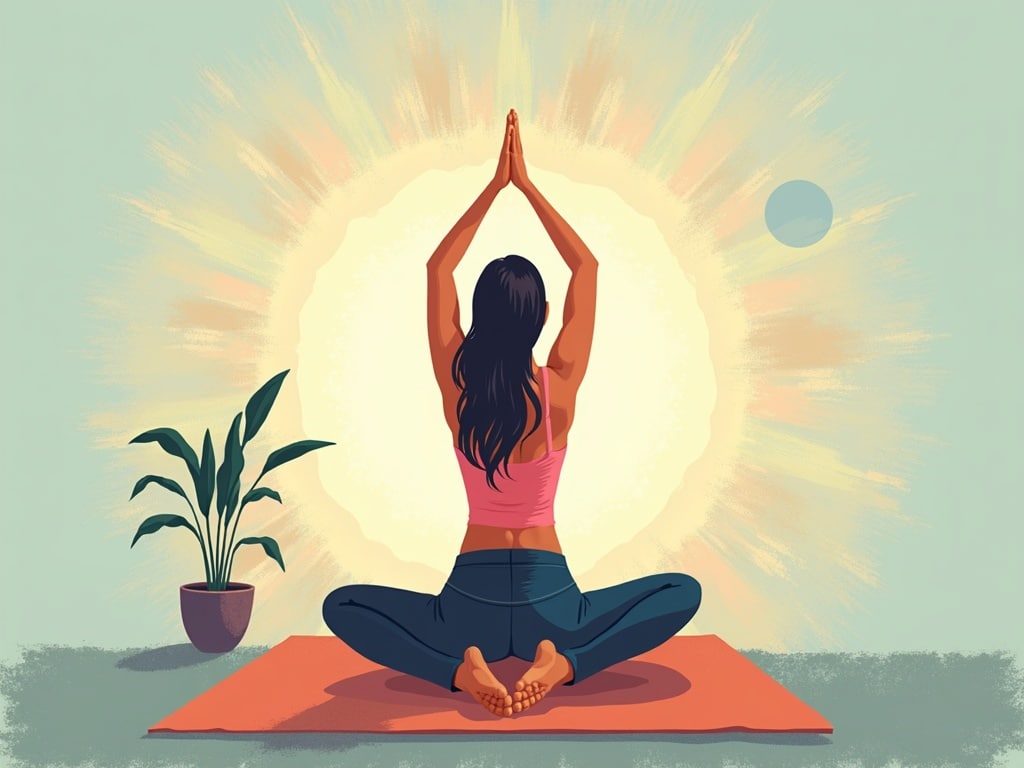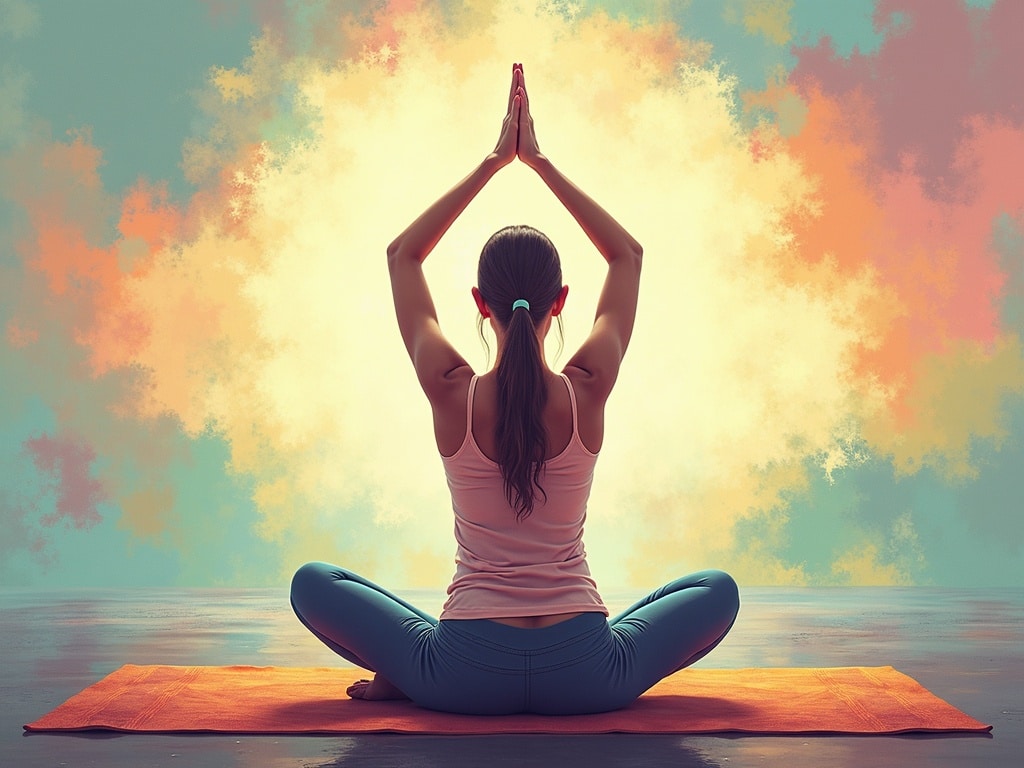Finding Your Calm: Yoga Poses for Stress and Anxiety Relief
In today's relentlessly paced world, stress and anxiety have become unwelcome, yet frequent, companions. The constant bombardment of information, the pressures of work and relationships, and the ever-present hum of technology can leave us feeling overwhelmed and disconnected from ourselves. But what if there was a way to quiet the noise, to find a pocket of peace amidst the chaos? Enter yoga, an ancient practice that offers a powerful antidote to the anxieties of modern life.
Yoga is more than just stretching; it's a holistic system that integrates the mind, body, and spirit. Through a combination of physical postures (asanas), breathing techniques (pranayama), and meditation, yoga can help to calm the nervous system, reduce stress hormones, and cultivate a sense of inner peace. And the best part? You don't need to be a contortionist to reap the benefits. Many simple yoga poses can be practiced by anyone, regardless of age or fitness level, to effectively manage stress and anxiety.
Understanding the Stress-Anxiety Connection
Before diving into the poses, it’s helpful to understand the physiological connection between stress and anxiety. When we perceive a threat (real or imagined), our bodies trigger the fight-or-flight response, flooding our system with hormones like cortisol and adrenaline. This can lead to increased heart rate, rapid breathing, muscle tension, and a general feeling of unease. Chronic stress keeps this system activated, leading to long-term anxiety, fatigue, digestive issues, and even a weakened immune system.
Yoga helps to interrupt this cycle in several ways:
- Activating the Parasympathetic Nervous System: Yoga encourages the rest and digest response, slowing heart rate, lowering blood pressure, and promoting relaxation.
- Reducing Cortisol Levels: Studies have shown that regular yoga practice can significantly reduce cortisol, the primary stress hormone.
- Increasing GABA Levels: GABA is a neurotransmitter that helps to calm the nervous system. Yoga has been shown to increase GABA levels in the brain, further promoting relaxation and reducing anxiety.
- Improving Body Awareness: Yoga cultivates a deeper connection to your body, allowing you to recognize and respond to signs of stress and tension before they escalate.
The Most Effective Yoga Poses for Stress and Anxiety
Ready to roll out your mat and find some relief? Here are some of the most effective yoga poses for calming the mind and body:
1. Child's Pose (Balasana)
This gentle pose is a natural stress reliever. It soothes the nervous system, calms the mind, and gently stretches the hips, thighs, and ankles.
How to do it:
- Start on your hands and knees.
- Bring your big toes to touch and widen your knees slightly.
- Sit back on your heels and slowly fold forward, resting your forehead on the mat.
- Extend your arms forward or rest them alongside your body, palms facing up.
- Breathe deeply and hold for 5-10 breaths.
2. Legs-Up-the-Wall Pose (Viparita Karani)
This restorative pose is incredibly calming and helps to reduce swelling in the legs and feet. It also promotes blood flow to the brain, easing anxiety and fatigue.
How to do it:
- Sit sideways with your right hip close to a wall.
- Gently swing your legs up the wall as you lie back on the floor, keeping your buttocks as close to the wall as possible.
- Rest your arms alongside your body, palms facing up.
- Close your eyes and breathe deeply for 5-15 minutes.
3. Corpse Pose (Savasana)
This deceptively simple pose is often done at the end of a yoga practice. It allows the body to completely relax and integrate the benefits of the practice.
How to do it:
- Lie flat on your back, with your arms alongside your body, palms facing up.
- Let your feet fall open to the sides.
- Close your eyes and consciously relax every muscle in your body, starting with your toes and working your way up to your head.
- Breathe deeply and evenly for 5-15 minutes.
4. Cat-Cow Pose (Marjaryasana to Bitilasana)
This gentle flow helps to release tension in the spine, shoulders, and neck. It also stimulates the digestive organs and calms the mind.
How to do it:
- Start on your hands and knees, with your wrists under your shoulders and your knees under your hips.
- Inhale, drop your belly towards the floor, and lift your chest and tailbone towards the ceiling (Cow Pose).
- Exhale, round your spine towards the ceiling, tuck your chin towards your chest, and draw your tailbone down (Cat Pose).
- Continue flowing between Cat and Cow poses for 5-10 breaths.
5. Forward Fold (Uttanasana)
This pose can be modifying by bending the knees. This pose helps to release tension across the back. This also reduces pressure in the lower back.
How to do it:
- Start by standing with your feet shoulder-width apart.
- Bend your knees slightly.
- Fold forward, resting your belly on you thighs.
- Let you arms hang loose, maybe holdinf opposing elbows.
- Release your lower back and neck.
- Continue breathing deeply for 5-10 breaths.

Breathing Techniques (Pranayama) for Enhanced Relaxation
Yoga isn't just about physical postures; it also incorporates breathing techniques that can profoundly impact the nervous system. Here are two simple yet powerful pranayama techniques for stress and anxiety relief:
1. Diaphragmatic Breathing (Belly Breathing)
This technique helps to activate the parasympathetic nervous system, slowing heart rate and promoting relaxation.
How to do it:
- Lie on your back or sit comfortably.
- Place one hand on your chest and the other on your belly.
- Inhale deeply through your nose, allowing your belly to rise while keeping your chest relatively still.
- Exhale slowly through your mouth, allowing your belly to fall.
- Continue breathing deeply for 5-10 minutes.
2. Alternate Nostril Breathing (Nadi Shodhana)
This technique helps to balance the two hemispheres of the brain, promoting a sense of calm and focus.
How to do it:
- Sit comfortably with your spine straight.
- Close your right nostril with your right thumb.
- Inhale deeply through your left nostril.
- Close your left nostril with your right ring finger and release your thumb from your right nostril.
- Exhale slowly through your right nostril.
- Inhale through your right nostril.
- Close your right nostril with your right thumb and release your ring finger from your left nostril.
- Exhale slowly through your left nostril.
- Continue alternating nostrils for 5-10 minutes.
Creating a Yoga Practice for Stress and Anxiety
Consistency is key when it comes to reaping the benefits of yoga. Aim to practice for at least 15-30 minutes most days of the week. Here are some tips for creating a sustainable yoga practice:
- Find a Quiet Space: Choose a place where you can practice without distractions.
- Set a Realistic Goal: Start with a short practice and gradually increase the duration as you feel comfortable.
- Listen to Your Body: Don't push yourself too hard, especially if you're new to yoga. Modify poses as needed.
- Be Patient: It takes time to develop a consistent yoga practice. Don't get discouraged if you miss a day or two. Just get back on your mat as soon as you can.
- Consider a Yoga Class: A qualified yoga instructor can provide guidance and support.
Beyond the Mat: Lifestyle Changes for Stress and Anxiety Relief
While yoga can be a powerful tool for managing stress and anxiety, it's important to address the underlying causes of these conditions. Here are some lifestyle changes that can complement your yoga practice:
- Prioritize Sleep: Aim for 7-8 hours of quality sleep each night.
- Eat a Healthy Diet: Focus on whole, unprocessed foods and limit your intake of sugar, caffeine, and alcohol.
- Stay Hydrated: Drink plenty of water throughout the day.
- Engage in Regular Exercise: Find an activity that you enjoy and do it regularly.
- Practice Mindfulness: Pay attention to the present moment without judgment.
- Connect with Others: Spend time with people who support and uplift you.
- Spend Time in Nature: Get outdoors and enjoy the beauty of the natural world.
- Seek Professional Help: If stress and anxiety are significantly impacting your life, consider seeking guidance from a therapist or counselor.
Embrace the Journey to Inner Peace
Stress and anxiety don't have to rule your life. By incorporating yoga and mindful lifestyle changes into your routine, you can cultivate a greater sense of calm, resilience, and inner peace. Remember, the journey to well-being is a marathon, not a sprint. Be patient with yourself, celebrate your progress, and embrace the transformative power of yoga.

